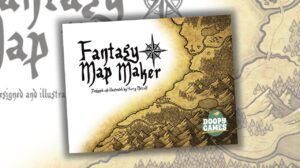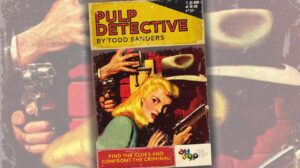There are games that come very close to being perfect. The mechanics weave in and out of the theme, which is reinforced by the artwork to create an experience that is far greater than the sum of the parts. But then there comes one element that hits like nails on a chalkboard, or a needle scratch that feels off, or causes issues.
There are some that are almost insignificantly minor (e.g., in Splendor, I do not believe that the gemstone a card produces should ever be a part of its cost). Others get louder with each play. This article is about the others, the rule or mechanic or aspect of a game that, once I saw it, bugs me every time I play the game.
Coup
Its missing one simple action!
Coup is a beautiful deduction game. It is a card-driven game with a small Court Deck containing three each of Ambassador, Assassin, Captain, Contessa, and Duke. Each player starts with two of these individuals and a couple of coins. Nobody knows who has who in their hands. Thus, players can bluff and claim to have an individual in hand they do not have.
Some actions a player takes can be blocked by those having (or claiming to have) some other individual in hand. Players can call out each other and say they do not have who they claim to: if they don’t have the individual in hand, they lose an influence (i.e., a card); if they do have the individual in hand, the player calling them out loses an influence. When you have no more influence, you are out.
The last player remaining wins. The actions you can take are:

The problem is that near the end of the game, it is often true that players become locked due to the fact that they have an individual in their hand that everyone has deduced, making a bluff impossible. To correct this, all that is needed is one simple, unblockable action that does not require a particular individual.
Bribe Pay 2 coins, take 1 card, return 1 card to the Court Deck. Cannot be blocked.
This is a half-Ambassador action that costs coins. Add this to the game and players have options to obfuscate their hand in the end game.
I have introduced this action into several games and it has always been a welcome addition.
Dice City
They missed the boat when it comes to gold!
My wife loves Dice City. I love it as well, but given that when the two of us play, I have about a 3% chance of winning this game, it holds a slightly lower position in my heart. 🙂
This is a game about building up a city within a 5×6 grid. At the start of the game, there are wild resources along the outer border and a few semi-developed areas inside. Using color-coded dice, the game allows you to activate specific spaces (e.g., if the red die comes up 4, then the space in the red row, 4th column does its thing).
Players gather up resources (ore, stone, wood) and use those to buy improved spaces to place within the city, or to send out ships for trade. They gather up soldiers (i.e. army strength) to attack the various bandits that threaten the kingdom (or attack other players, although this is rarely an efficient move).
There is a mechanic in the game where, if you do not want to use the space that was activated for what it normally does, you can use it to gain a pass token. These look like hourglasses.
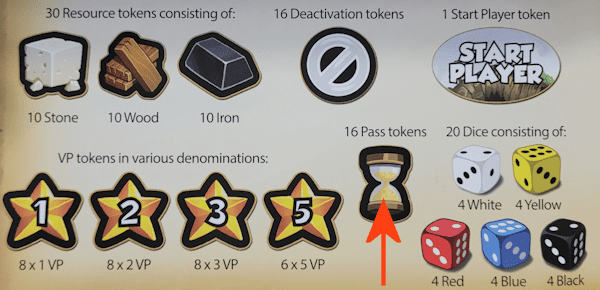
Two pass tokens can be spent as any of the other resources, as a temporary boost to your army strength, or to force all other players to re-roll a die of your choice. Most of the time, this is a resource or army strength. In later expansions, they introduced Gold to the game. Gold is not considered a resource, but it can be used as any resource.
I really think they messed up here.
I believe that the original game should have replaced the pass tokens with gold tokens, then they should be used just as the rules state: two gold can be used to gain any resource, or improve the army strength. Then:
- The expansions have a 1:1 exchange for resources; keep it 2:1 (as in the base game).
- The expansions have gold mines. Remove them.
- The expansions have a hard limit on the total amount of gold in the game. Remove the limit.
As far as everything else is concerned, treat these new gold tokens exactly as gold is used in the game.
Trust me. Gold suddenly makes a lot more sense.
Dixit
You should always have six cards to choose from!
Dixit is a game with some of the most beautiful artwork I have ever seen in a game. Gameplay and scoring are inspired. Each player has a hand of cards with various (odd) pieces of artwork on them. One player each round is the active player (clue-giver), who selects one card from their hand and places it face-down on the table. They then give a clue.
Each other player then looks in their hand and tries to find a card they have that could potentially be the answer to the given clue. When they have made a choice, they pass that card face-down to the active player who creates a stack of the cards. They then shuffle them up and place them out next to the board (the board has six numbered spaces for the cards to go into).
Coming up with and giving that clue is a deliciously tense moment for the active player. They need to give a clue that is vague enough that at least one player will not be able to figure out which of the cards is theirs, but clear enough that at least one player will be able to figure it out. All this is because of the gorgeous scoring system:
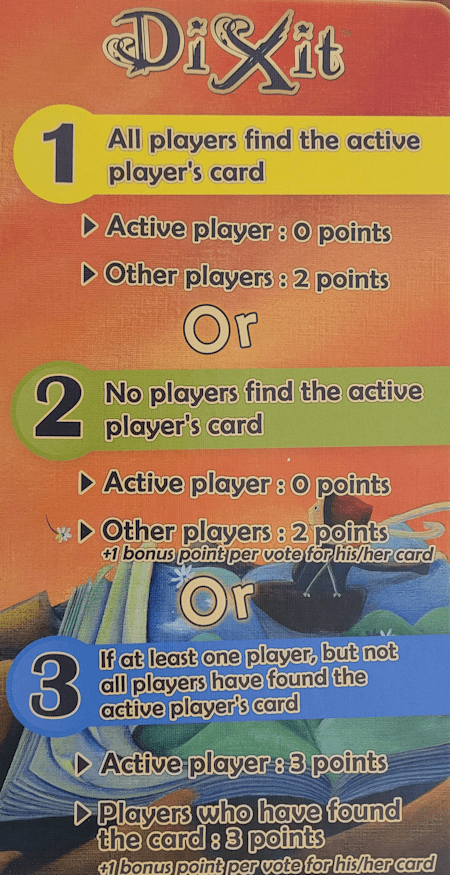
Players use numbered tokens to vote. They cannot vote for the card they put in (for obvious reasons). Once everyone has chosen, the votes are revealed and the round is scored. The first player to 30 points wins!
So where is the problem? The problem is when you have fewer than six players, the number of cards to choose from is less than six. This makes for a less-than-exciting game due to the lack of choices. Each player knows that the card they put in is not the target, so in a six player game they have five cards to choose from.This is reduced with each missing player, making the guesswork much easier.
The solution is simple. In a game with fewer than six players, after the players have all given the active player the cards they are putting into the mix, the active player then draws a number of random cards from those not in play to bring the stack to six cards. Shuffle everything together, and put out the six.
No rules change. Scoring works exactly as it always has. It is just that some random cards are included. I have to say, people guessing one of the random cards happens far more often than you would suspect! I have seen rounds where every vote was for a random card—even the active player thought that card was the best fit for the clue!
Mysterium Park
It needs better vision artwork!
Let me say up front: the vision card artwork in Mysterium Park is very good and evocative—as artwork. They are not very good, however, for the purpose of leading a player to a suspect or location. So much of the artwork has a similar feel to it: dark, filled with carnival lights, and often (for reasons I have yet to wrap my head around) evoking aliens.
In this game, one player is a ghost who has been murdered by one of the people at the Mysterium Park carnival. Each round is spent with the ghost sending visions to the psychic detectives (the other players) in an effort to lead them to the innocents, then to lead them to the locations they can cross off their list.
The remaining three suspects and locations are then put before the psychics and the final visions are sent. If the psychics can guess the who and where of this murder, the ghost can rest and the players win. Otherwise, the ghost is doomed to walk the earth and an innocent person goes to jail.
The direction of the clues is reversed as compared to the original Mysterium. When I first read that, I thought this was an odd choice. And it is, but it results in much better overall gameplay than the original. Other changes that were made also streamline and improve the flow of the game (e.g., players are always at the same stage, the final round is handled much better, etc.).
The problem is the vision cards. In the original Mysterium, every single piece of artwork was a fever dream of possibilities. You could focus on this element or that to deduce what the ghost was telling you. Sometimes you focus on the wrong thing, and that is great! The images are meant to be this beautiful combination of vague and specific. But the vision cards in Mysterium Park are not like that.
The vision art in Mysterium sometimes appears random, dreamlike. The vision art in Mysterium Park appears to have been made under the instruction to make it appear random. It feels like certain things were dictated to the artist rather than to allow the art to feel dreamlike. It becomes too solid, too tangible.
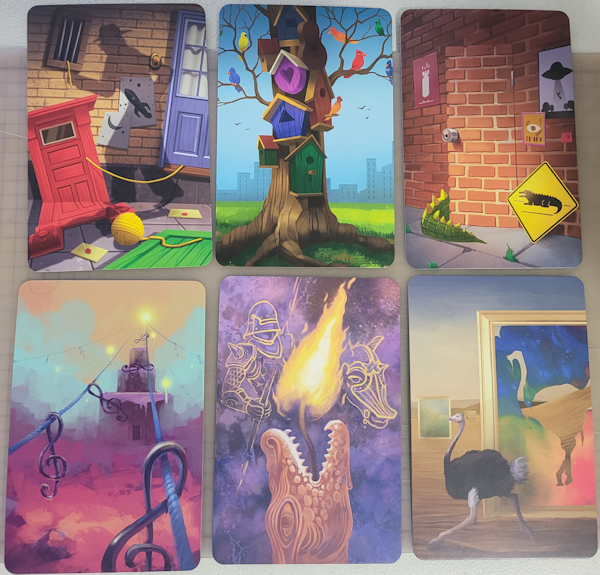
What I suggest is using the board and rules for Mysterium Park, but use the cards from the original. This way, you get all the improvements to gameplay while being able to use artwork much better suited for this type of game.
Then again, judging art is very subjective. Maybe this is just a ‘me’ thing.
Star Trek: Ascendancy
Oh dear lord, the making of the board!
The idea that the gameboard can be built as the game is being played is nothing new. Several games do this and do it quite well (e.g., Eclipse). Some games are entirely that (e.g., Carcassonne). But Star Trek: Ascendancy goes a step further with a game board that lacks true structure. There are no hexes or squares, there are discs that represent star systems and lengths of space-lane connecting them.
When you look at the rulebook, what they expect to see players doing looks something like this:
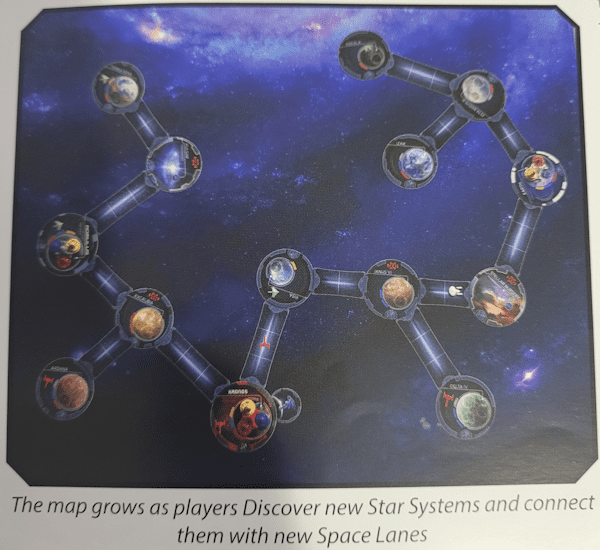
However, all too often, a player will not want to connect with the other players. And so they will turn their systems inward and remain distant by creating a crazy zig-zag pattern of systems back toward their own side of the board. I have seen boards that look more like this:

Please note that the second one has more systems than the first, and they are not even close to coming into contact with one another. So the game drags on with each player building up and building up, hoping to reach the victory and game-end trigger without any contact or conflict.
I am not sure what the optimal fix for this issue might be, but I can say I have a couple of ideas!
- The shortest of the space-lanes is a two-space piece. Make a rule that no two systems can be closer than that space-lane (connected or not).
- The space-lanes have a nice width to them. Make a rule that no two space-lanes around a system can be so close that another space lane would not fit between them.
Do either (or both) of these, and this nonsense can no longer happen.
Wingspan
Eggs should not be worth points at the end of the game!
The problem with the fact that eggs are worth points was brought up early in the game’s history. Several reviewers noted that the best strategy for the last two (or three… or four…) actions in Wingspan are usually to stop doing anything and simply lay more eggs. Nothing else, they argued, generates the points of this simple strategy.
Consider that the other options are to draw cards (not generally worth any points), gain food (not generally worth any points), or to play birds (which must be worth at least 3 points at the end of the game to be worth anything, as they will usually cost you 2 eggs to play them). All of this is weighed against taking an action that nets you 3 or more (often much more) points with no effort.
This is not the only problem with eggs, as they are already getting you points in other ways. A large chunk (i.e., more than one-third; 13 of 34) of the end-of-round goals are centered on having eggs—in specific nests, in specific habitats, etc. Eggs are already valuable. They do not need to score on their own.
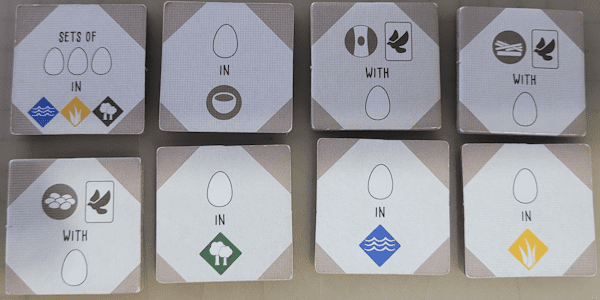
Consider that the objects placed with birds on the player boards that are locked into place (e.g., tucked cards, cached food) are worth points. Those objects are not, however, a currency in the game. The other currency objects a player acquires (e.g., personal food supply) are not worth points. Eggs are treated in an odd way, unnecessarily.
I believe the game would be greatly improved if this one rule—this one mechanic—were removed. Eggs already have many other ways within the rules as written to score points for the player. There is absolutely no need for them to be a part of the standard scoring at the end of the game.
These are six games I think can be greatly improved with a small tweak to the rules. I can house rule the over-the-table plays, but in this post-COVID age, when so much of my game-play is via Board Game Arena or Steam, I cannot fix these things. Sigh.
Do you agree with my assessments? What other games could be perfect were it not for that one thing?










